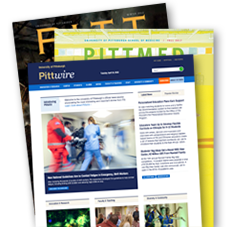"Stretched" Material Could Lead to Next Generation of High-Speed Electronic Devices
PITTSBURGH—A team led by researchers at the University of Pittsburgh and Penn State University has created a new material that the scientists say promises to out-perform all other known materials for use in high-frequency devices.
"The technological implications are staggering," said Jeremy Levy, an associate professor in Pitt's Department of Physics and Astronomy, who investigated the properties of the new material, a novel form of strontium titanate. He and his fellow researchers transformed the normal properties of strontium titanate (a synthesized, crystalline material made up of the metals strontium and titanium, plus oxygen) by stretching it, atom-by-atom, according to a report published Aug. 12 in the journal Nature.
The result is a form of strontium titanate that is "ferroelectric"—i.e., it has a natural, spontaneous electric polarization that can be reversed by the application of an electric field—at room temperature. The new material could have a variety of commercial applications and might even lead to the next generation of high-speed electronic devices, researchers believe.
"Ordinarily, strontium titanate is not ferroelectric even at absolute zero, the lowest temperature attainable," Levy noted. "The quality of this material has been found to be so high that its performance in high-frequency devices exceeds that of all other known materials." Applications for the new material could range from use in cell phones capable of operating at lower power than current models to high-density, nonvolatile storage media for computers, Levy said.
Creating the stretched strontium titanate is akin to stretching a bed sheet beyond its normal limits, explained Darrell Schlom, professor of materials science and engineering at Penn State, where the stretched material was synthesized. In this case, the "bed sheet" is strontium titanate and the "bed" is a newly synthesized crystalline material, dysprosium scandate. "What we are doing is stitching, atom by atom, the 'bed sheet' of strontium titanate to the 'bed' of dysprosium scandate," Schlom said.
"In doing so, we can prevent the strontium titanate from wrinkling or tearing, and we can transform the properties of this sheet of material in ways that are impossible to do otherwise."
The distances between adjacent atoms in strontium titanate and dysprosium scandate agree to within 1 percent, close enough to make the stitching possible. The atomic separation for the film of strontium titanate, however, is slightly smaller than for the substrate of dysprosium scandate, so the film is forced to stretch in order to grow properly. In doing so, the properties are significantly altered, allowing the material to become ferroelectric at room temperature.
The research was supported by a $750,000, three-year grant from the National Science Foundation.
###
8/17/04/blg
Media Resources
Schools of the Health Sciences Media Relations
For more information about Pitt's schools of dental medicine, health and rehabilitation sciences, medicine, nursing, pharmacy, and public health, click here >
To locate stories from health science schools prior to 2013, visit the UPMC news archives »
Urgent Question?
University of Pittsburgh news reps are available to answer urgent media inquiries. Outside of regular business hours (Mon-Fri, 8:30 a.m.-5 p.m.), please email us at media@pitt.edu.
News reps for University of Pittsburgh Health Sciences schools can be reached outside of regular business hours through the paging operator at 1+412-647-2345.


